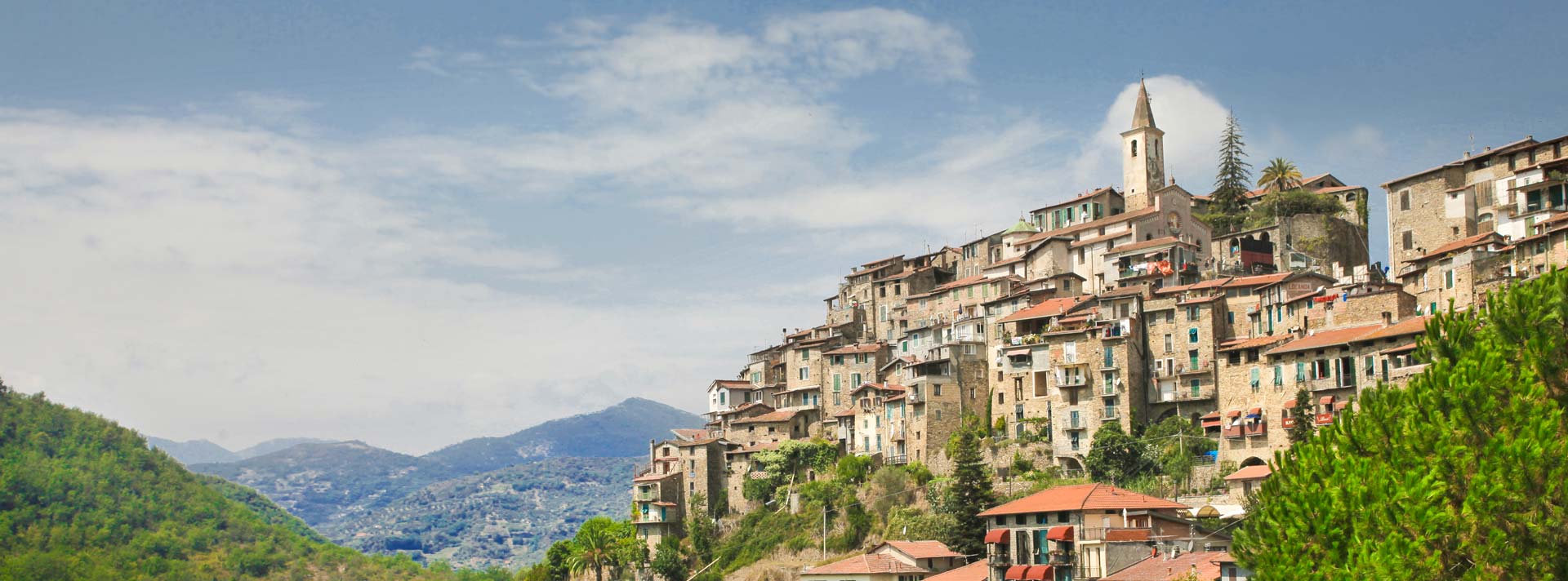

Things to do and SEE
Inland Imperia
The beauty of the Province of Imperia is more than just the dazzling coast. Inland also attracts the tourist with its sunny valleys dotted with serene holiday resorts and ancient, picture-postcard hamlets, villages and castles straight out of the Middle Ages.
Here are a few of the myriad of interesting and often, breathtaking places on offer.
Villages and Towns
Cervo, one of Italy’s most beautiful ancient hamlets, perched up above the valley.
Villa Faraldi, an ancient village with houses clustered around the parish church which preserves a plaque from the 1st century BC testifying to the existence of an ancient Roman colony.
Diano Castello, immersed in the woods and olive groves.
Imperia, the provincial capital, combining Oneglia and Porto Maurizio.
Colle di Nava, known for its beautifully scented lavender.
Bestagno, one of the oldest villages in Western Liguria. Its castle was, for a long time, the strongest fortress defending Oneglia. The church, too, is one of the oldest in the valley.
Chiusavecchia, immersed within the enchanting olive groves.
Pieve di Teco, an ancient hamlet complete with castle, and famous for its handcrafted shoes.
Villages and Towns
Cosio d’Arroscia, small village frequented by tourists and hunters, well worth visiting for its beautiful Church of the Assumption of Our Lady with its massive Roman bell tower.
Monesi, winter ski resort and summer holiday spot. Monesi is connected by a chair lift to the Statue of the Redeemer (at over 2000m). The statue, at 14 m high, dominates the vast, breathtaking panorama of hills and mountains stretching out from Mount Saccarello (one of the tallest of the Ligurian Alps) to Monviso in Piedmont.
Badalucco, an ancient medieval hamlet with stone houses and painted walls.
Molini di Triora, picturesque cluster of houses with slate roofs, culminating in the Sanctuary dedicated to Mary, called Madonna della Montà (‘of the climb’), containing frescoes from the 15th century.
Triora, well-known as the village of the witches complete with museum, this beautifully preserved medieval village, high up on the hill, dominates the Valley of Argentina.
Pigna, a name that perfectly suits this characteristic village, whose houses really do pile up like a ‘pigna’ or pine cone, forming narrow and steep alleys surmounted by arches and dark vaults.
Isolabona, a typical Ligurian mountain hamlet which preserves a beautiful fountain of the sixteenth century and the ruins of a thirteenth-century castle, in an area scattered with other typical Ligurian villages.
Villages and Towns
Apricale, another beautiful medieval village well-worth a visit. The presence of a sailing ship in the municipal coat of arms, quite curious for a medieval village perched inland, is explained by the historical collaboration between the town and the shipyards of the coast; in fact, the wood used in the construction of the fleet of the Republic of Genoa came from the woods of Apricale.
Perinaldo, a medieval village situated in a wonderful panoramic position. The birthplace of three great astronomers, it is famous for its astronomical observatory.
Baiardo, a village that appears like a fantastic vision, perched on the top of a mountain, streaked with bands of crops and in the centre of a vast amphitheatre of hills where chestnut trees alternate with pines.
Ceriana, another medieval village with winding streets and ancient houses that seems to be slipping down an almost sheer slope.
Bussana vecchia, almost completely destroyed by the 1887 earthquake, it was abandoned by all its inhabitants. Only the bell tower remained intact. It is now home to a small group of local inhabitants and international artists.
Vallebona known for its representations of the “Mysteries of the Passion of Jesus”, in which the inhabitants of the village themselves take part.
Seborga a small tourist spot which, in the Middle Ages, was the seat of a Principality, that once had the rights to press and mint coins.
Sport
The cycle track (pista ciclabile) the longest in Europe along the coast, the riding stables, bowling and the Parco Avventura at Mendatica, the countless paths and trails for trekking and mountain bike, are just a few of the vast number of activities on offer in Liguria.
Throughout the summer season, the Hotel organises excursions and trekking in the hinterland.
In addition, for those guests who are cycle enthusiasts, Villa San Giuseppe offers a bike workshop for carrying out small repairs, bike parking and free bike hire.



